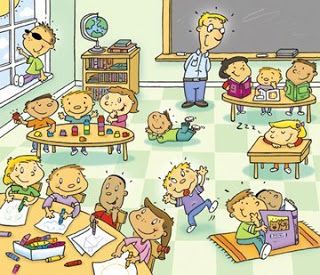Cha-Cha Slide into the Room Maneuvering Mambo!By ISJL Education Fellow Julia Kunis
Classroom set up, at times, can be tricky. Sometimes, we assemble our classrooms with what we are used to or what is seen as a typical classroom set up. Think of a chalk board on the wall with a teacher’s desk right at the front of the room, students’ desks lined up in nice and neat rows facing the teacher’s desk, and a few motivational posters hanging above the board. A bit traditional, right? And not much room for kinesthetic learning. In reality, students’ minds do not think as hard lined as the adults teaching them. Students need less rigidity and more opportunity to move, create, and be inspired. This starts with the classroom set up. The Foundation We are always looking for ways to engage with our students. Classroom orientation greatly affects the way in which students learn. From seating arrangements, to the placement of the teacher’s desk, and even to where specialized learning areas are located, all of these exterior factors contribute to the way in which our students experience learning in the classroom. Let’s start with a foundation on which we can build upon in creating a more inspiring classroom. Pages 312 to 313 in this textbook chapter list ways in which space arrangement help inspire movement, creativity, and uphold student safety. Utilize this resource as a starting point, a foundation to introduce more kinesthetic learning into the classroom. The Challenge Want a challenge? Invite students to help develop the classroom set up. Empowering students to make their own choices and giving them the space to advocate for their classroom visions generates a sense of individuality and belonging to not only their classroom but to their Jewish education. In addition, acknowledging a class’s voice calls for an opportunity to work and problem-solve together as a community. The classroom acts as a microcosm for students. It is a place where children and teens learn, contemplate, and experience Judaism for the first time and develop the background for future Jewish identities. Through this kinesthetically-driven intention, educators help students move one step closer to forging closer connections with community, culture, and core values. The Execution Still, the question remains, how can we leave classroom set up in the hands of our students? This can be uncomfortable, especially since we often stick to what we know and have been doing for years. Ultimately, it is meaningful to delegate only certain matters to students. Consider asking for advice about where the class would like to display artwork, how students want to arrange chairs or tables, or the kind of alternative spaces the class would like to create. If anyone is interested in more guidance, they can also utilize this online resource. Once students and teachers are on the same page, the class can move from the brainstorming phase to implementing their creative ideas! The point of this method is to give students just enough agency in the classroom to feel that they are making their own decisions while working together to build kehillah (community) in a Jewish setting. The physical movement of moving the chairs, tables, desks, etc. symbolizes the choices they make in leading Jewish lives. Just as it is our goal as educators to have students lead Jewish lives outside the classroom and in the future, we must give them the opportunity to develop a sense of individuality, belonging, and ownership now in the Jewish classroom. |
- Home
- WHO WE ARE
-
WHAT WE DO
- PODCAST
- Conference >
- Education >
-
CULTURE
>
- Culture Overview
- Cultural Programming >
-
History
>
-
Encyclopedia of Southern Jewish Communities
>
- Alabama Encyclopedia
- Arkansas Encyclopedia
- Georgia Encyclopedia
- Florida Encyclopedia
- Kentucky Encyclopedia
- Louisiana Encyclopedia
- Mississippi Encyclopedia
- North Carolina Encyclopedia
- Oklahoma Encyclopedia
- South Carolina Encyclopedia
- Tennessee Encyclopedia
- Texas Encyclopedia
- Virginia Encyclopedia
- Encyclopedia Credits
- Oral History
-
Encyclopedia of Southern Jewish Communities
>
- SPIRITUALITY >
- DONATE
- Shalom Y'all
- Strategic Plan
- Southern & Jewish Blog
- Calendar
- Virtual Press Kit
|
©2024 Goldring/Woldenberg Institute of Southern Jewish Life
|

